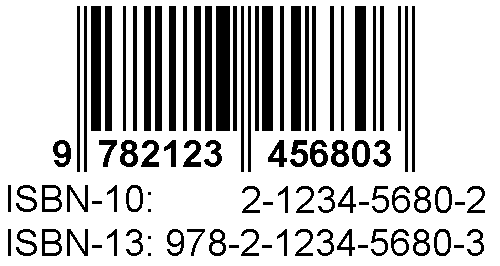In the ISBN-10 (International Standard Book Numbering) system that was used until the end of 2006, each book is assigned a unique 10-digit code. The first nine digits uniquely identify the book itself, whereas the last digit merely serves as a check digit to detect invalid ISBN-10 codes.

If $$x_1, \ldots, x_9$$ represent the first nine digits of an ISBN-10 code, the check digit $$x_{10}$$ is computed as \[ x_{10} = (x_1+ 2x_2+ 3x_3+ 4x_4+ 5x_5+ 6x_6+ 7x_7+ 8x_8+ 9x_9)\!\!\!\!\mod{11} \] As a result, the check digit $$x_{10}$$ always takes a value in between 0 and 10. If the check digit is equal to 10, it is represented by the uppercase letter X in the ISBN-10 code. As such, only a single character is needed to represent the check digit.
In the new ISBN-13 system, each book is assigned a unique 13-digit code. The first twelve digits uniquely identify the book itself, whereas the last digit merely serves as a check digit to detect invalid ISBN-13 codes. If $$x_1, \ldots, x_{12}$$ represent the first twelve digits of an ISBN-13 code, the check digit $$x_{13}$$ is calculated as \[\begin{align} o &= x_1 + x_3 + x_5 + x_7 + x_9 + x_{11} \\ e &= x_2 + x_4 + x_6 + x_8 + x_{10} + x_{12} \\ x_{13} &= (10 - (o + 3e)\!\!\!\!\mod{10})\!\!\!\!\!\mod{10}\end{align}\] As a result, $$x_{13}$$ always takes a value in between 0 and 9, so that ISBN-13 codes only contain digits.
Assignment
-
Write a function isISBN that takes a string $$c$$ (str). The function must return a Boolean value (bool) that indicates whether $$c$$ is a valid ISBN code. The function also has an optional second parameter isbn13 that may take a Boolean value (bool) indicating whether the function must check for an ISBN-10 code (False) or for an ISBN-13 code (True, default value).
-
Write a function areISBN that takes a list containing $$n \in \mathbb{N}$$ codes. The function must check whether each code in the given list is a valid ISBN code. The function also has an optional second parameter isbn13 that may take a Boolean value (bool) indicating whether the function must check for ISBN-10 codes (False) or for ISBN-13 codes (True).
If no value is explicitly passed to the parameter isbn13, the type of the code must be derived from its length. Codes that are no strings (str) are considered to be invalid by definition. Codes having length 13 must be checked as ISBN-13 codes and codes having length 10 must be checked as ISBN-10 codes. Codes having a length that deviates from 10 and 13 are considered to be invalid by definition.
The function must return a new list containing $$n$$ Boolean values (bool) that indicate whether the code at the corresponding position in the given list is a valid ISBN code.
Example
>>> isISBN('9789027439642', False)
False
>>> isISBN('9789027439642', True)
True
>>> isISBN('9789027439642')
True
>>> isISBN('080442957X')
False
>>> isISBN('080442957X', False)
True
>>> codes = ['0012345678', '0012345679', '9971502100', '080442957X', 5, True, 'The Practice of Computing Using Python', '9789027439642', '5486948320146']
>>> areISBN(codes)
[False, True, True, True, False, False, False, True, False]
>>> areISBN(codes, True)
[False, False, False, False, False, False, False, True, False]
>>> areISBN(codes, False)
[False, True, True, True, False, False, False, False, False]
Ask Pythia …
In the following instruction video, Pythia explains how to tackle this assignment. Watch this video as a stepping stone to solve other exercises about advanced functions and modules1.